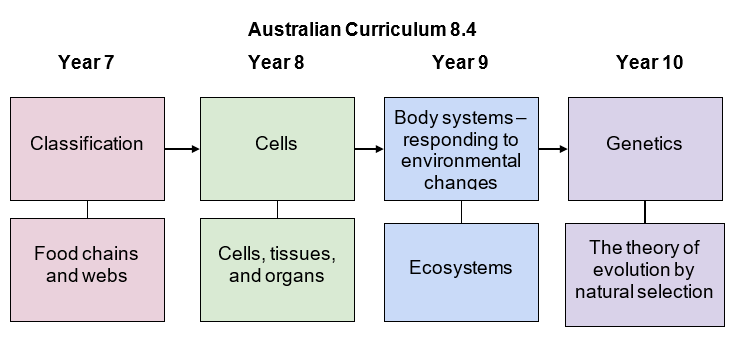
by Jacqui Bennett
Biology is often considered to be the most relatable science subject to students. The concepts tend to be more easily observed in nature, or relate to students’ own bodies (e.g. cells, organs). Something else that can be easily observed by teachers are the small changes to topics in Biological sciences for the new Australian Curriculum v9.0.This was the sequence of topics across Years 7-10 Biology previously:

This is the sequence for the Australian Curriculum v9.0:

Year 7 is still centred on nature and organisms. The classification topic is very similar, but two elaborations now specifically mention dichotomous keys – not really a change as most teachers would have been covering these already. The elaboration about how biological classification has changed over time has the addition of ‘through improvements in microscopy’. Again, this is not much of a change to resources as most teachers would already be talking about how classification changed over time due to improvements in technology.
One big change is that instead of revisiting the ecosystems/food webs topic in Year 9, it is now all in Year 7. However, don’t think this means the topic is jam packed: it now has two fewer elaborations. The focus has shifted to impacts on ecosystems, which is good as it will give students a more holistic understanding. The new elaborations involve feeding relationships and energy flow (using food webs), predicting the effect of the removal of predators and pollinators, and the effect of man-made and seasonal events on abiotic and biotic factors. Sounds like minimal to no changes to resource use in Year 7.
Year 8 still focuses on cells. It seems ACARA is trying to bring cells into the modern age, expecting students to explore cells using ‘augmented or virtual reality’ (not just ‘digital technology’ as it said in the past). The big challenge will be schools accessing the technology to do this! Another elaboration talks about viewing cells using digital microscopes, simulations, and photomicrographs. Again, this is a bit out of touch in terms of the equipment in the average science classroom, and may be difficult for some schools to do.
The remaining elaborations are pretty standard: microscopes, cell organelles (with six specifically mentioned), comparing plant and animal cells, and representing cells using physical or digital models. Notable absences are cell reproduction and mitosis, which can be difficult concepts for Year 8 students. So, it may be for the best that these have been moved to Year 10.
The cells, tissues, and organs topic has minimal changes. Reproduction has been moved to Year 9, so that is no longer a system to cover. This leaves more space for the usual topics, with the additions of cell and tissue disorders, and how artificial organs work. These two elaborations lend themselves to some interesting research activities, which I have found to be an engaging and practical way to cover topics without too much additional teacher preparation time.
In Year 9, the body systems topic now has elaborations that are more specific – such as providing examples of external stimuli, parts of the regulatory system, and explicitly mentioning negative feedback mechanisms. Luckily, at its core it is the same topic, so resources may only need slight adjustments after all – like talking about the effect of insulin and electrolytes instead of X-rays and microwaves.
Year 9 also expands upon body systems to include reproductive systems as its own topic. The emphasis is on reproductive cells and organs in animals and plants, and comparing sexual and asexual reproduction. Previously, schools might have skipped this system in Year 8 due to time constraints, so teaching this as a whole topic may be a challenge for some. However, placing this topic after regulation and coordination means students will already have an idea about what hormones do to the body – which does lead nicely into reproduction.
Year 10 still contains genetics and natural selection. The genetics topic overall is very similar, just with more specific elaborations. The content descriptor mentions meiosis AND mitosis, however mitosis is not included in any of the elaborations. I have always found that it makes sense to teach them together since they are similar processes, providing an overview of mitosis as a way to introduce meiosis. Hopefully many others will find they already do this too, and therefore not need to change anything – especially as it sounds like not much detail would be needed for mitosis. The natural selection topic is the same as before (with very slight inconsequential wording changes). So, overall Year 10 requires minimal to no changes in how it is taught.
Hopefully this information makes it clear that there are few changes to Biology in Years 7-10. Your energy can flow into minor tweaks and reproducing resources from previous years. I think this opportunity to build on existing resources will allow students to maintain a negative feedback loop of excitement and joy for Biological sciences.
Jacqui Bennett is the Science Content Associate at Edrolo.


